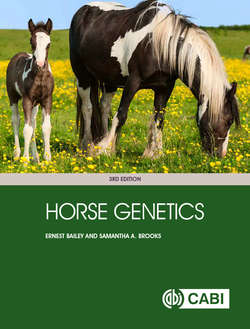Читать книгу Horse Genetics - Ernest Bailey - Страница 29
На сайте Литреса книга снята с продажи.
Chromosomal differences among the Equidae species
ОглавлениеAt the cellular level, one of the most striking differences among equids is the diversity in chromosome number. They range from 32 chromsomes in the Hartmann Zebra (E. hartmannae) to 66 in the Przewalski Wild horse (E. przewaslkii). Chromosomes are large molecules in the cell that contain the DNA and its associated proteins. (Chromosomes are discussed in more detail in Chapter 17.) The amount of DNA among all mammals is very similar, but it is packaged differently in different species. Chromosomal morphology and chromosome numbers in the living members of the genus Equus are distinctive for each of the extant species. As an illustration of this diversity, the chromosome numbers found for the species of the four major groups noted above are shown in Table 3.1. In several species, variation in chromosome number has been described and these numbers are shown. Usually, these variants appear to be simple fusions or fissions of two chromosomes. Data are compiled from information in Ryder et al. (1978), Benirschke and Ryder (1985), Bowling and Millon (1988), Ryder and Chemnick (1990), and Houck et al. (1998).
The scientific name of the species is given in the far-left column, followed in subsequent columns by common names and the number of chromosomes reported for each species. The practice is to type the genus and species name in full the first time it is used, and then simply abbreviate the first letter(s) thereafter. So Equus caballus becomes E. caballus. In some literature, the horse is designated Equus ferus and includes both the domestic horse and the Przewalski horse. When using that convention, the domestic horse is given the subspecies designation “caballus” (E. f. caballus) and the Przewalski horse is likewise designated E. f. przewalskii. As described in Chapter 2, the two species diverged between 41,000 and 70,000 years ago and are distinguishable species at the DNA level. Therefore, we will use the convention of referring to them with the species designations, E. caballus and E. przewalskii.
The chromosomes of domestic horses and donkeys are well known from clinical karyotyping studies, as well as genome mapping studies, and excellent ideograms exist that depict the number and structure of the chromosomes in these species (Bowling et al., 1997; Raudsepp et al., 2000; Di Meo et al., 2009). However, relatively fewer karyotyping studies have been undertaken for the wild equids, and some variation has been noted in their karyotypes. We do not know whether the individuals studied had clinically abnormal karyotypes or whether this variation represents hybridization between chromosomally heterogeneous populations that were brought together in recent history.
